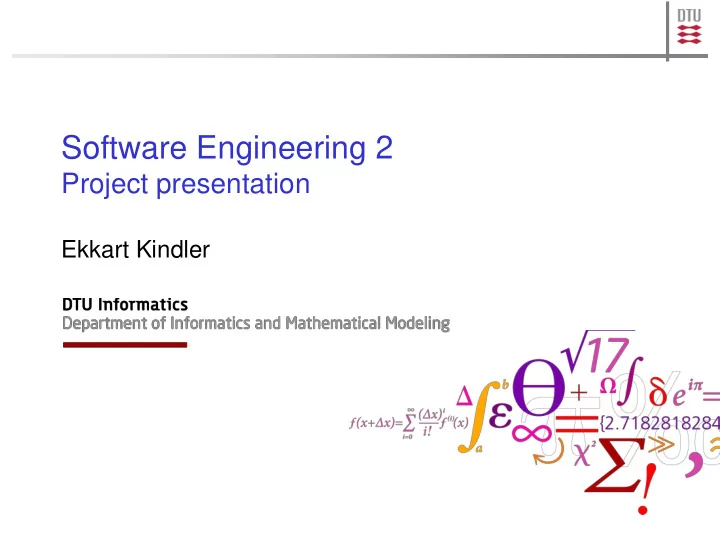

Software Engineering 2 Project presentation Ekkart Kindler
Project in a nutshell Ekkart Kindler Petri net Animation info shape: train animation: move geometry: track1 ... + «3D models» ... Simple interactive 3D animation of a system SE2: Project 2
Outline of talk Ekkart Kindler What are Petri nets? What do we need to add for animating behaviour in 3D? Some more detailed concepts! More detailed requirements! SE2: Project 3
Petri nets: Example Ekkart Kindler request 1 request 2 critical 1 critical 2 semaphor idle 1 idle 2 SE2: Project 4
Petri nets: Example Ekkart Kindler request 1 request 2 critical 1 critical 2 semaphor idle 1 idle 2 SE2: Project 5
Petri nets: Concepts Ekkart Kindler Places: Transitions: Tokens: Arcs: Marking: A distribution of tokens on the places (there may be more than one token on a place) SE2: Project 6
Petri nets: Firing rule Ekkart Kindler before (must be there after (are and are consumed) produced) SE2: Project 7
Firing rule Ekkart Kindler before (must be there after (are and are consumed) produced) Other tokens might be there (do not change) SE2: Project 8
Example: Toy train Ekkart Kindler SE2: Project 9
Toy train: Simple net Ekkart Kindler track4 track3 c 6 .track6 track5 track2 track6 track1 SE2: Project 10
Models for components Ekkart Kindler x: semicircle track x: line track SE2: Project 11
Models for components Ekkart Kindler x: signal track track n1.track x: switch x.track n2.track SE2: Project 12
Signal: Detailed model Ekkart Kindler x: signal track go stop SE2: Project 13
Switch: Detailed model Ekkart Kindler track x: switch track left right track SE2: Project 14
Outline of talk Ekkart Kindler What are Petri nets? What do we need to add for animating behaviour in 3D? Some more detailed concepts! More detailed requirements! SE2: Project 15
Animation info Ekkart Kindler Geometric information arrangement of tracks (geometry) Physical appearance appearance of objects (3D model/shape) appearance of tracks (mostly texture) Animations “Behaviour” of a token while on a place SE2: Project 16
Animation information Ekkart Kindler x: line id: 1 finished id: 1 shape: train geometry: animation: move … geometry: track1 line: id = track1 x1, y1, x2, y2 shape: track … SE2: Project 17
Outline of talk Ekkart Kindler What are Petri nets? What do we need to add for animating behaviour in 3D? Some more detailed concepts! More detailed requirements! SE2: Project 18
Animation information Ekkart Kindler x: signal id: 1 finished id: 1 shape: train id: 2 id: 2 <keep animation> animation: move shape: sigGo geometry: geometry: track2 action: appear, trigger … geometry: sig1 line: id = track2 finished x1, y1, x2, y2 finished shape: track shape: sigStop point action: appear, trigger id = sig1 geometry: sig1 x3, y3 SE2: Project 19
Screenshot Ekkart Kindler SE2: Project 38 20
More fancy version Ekkart Kindler SE2: Project 21
Which shape? Ekkart Kindler How do the following shapes look like? train Shapes corresponding to tokens: sigGo dynamic shapes sigStop Shapes corresponding to geometry track objects: static shapes The appearance of each shape is defined in a separate models file a reference to a VRML model for a dynamic shape (you are free to use other models) a profile and a texture for a static shape SE2: Project 22
Objective Ekkart Kindler Simple extension for equipping a Petri net model with a 3D-visualization Cheap way of showing a customer what a system modelled as a Petri net would really do – for validation purposes SE2: Project 23
Task Ekkart Kindler Re-implementation of PNVis based on a new model-based Petri net tool (the ePNK) and with more modern development technologies (EMF) SE2: Project 24
Outline of talk Ekkart Kindler What are Petri nets? What do we need to add for animating behaviour in 3D? Some more detailed concepts! More detailed requirements! (will be continued) SE2: Project 25
Sub tasks Ekkart Kindler Extended Petri net type for the ePNK that covers the extensions that are needed for the animations Graphical editor for geometries (points and lines the ”Petri net animations” refers to) Editor for defining the appearance of objects and tracks (refering to external 3D-models and textures) Simulator for the extended Petri net type that interacts with the 3D animation engine 3D animation engine that interacts with the Petri net simulation (and with the end user) GUI for starting and controlling 3D animations from a simple configuration file SE2: Project 26
Further information Ekkart Kindler SE2 project page: http://www2.imm.dtu.dk/courses/02162/e13/project/ Ekkart Kindler and Csaba Páles: 3D-Visualization of Petri Net Models. In: J. Cortadella and W. Reisig (eds.): ICATPN 2004, LNCS 3099, pp. 464 – 473, Springer 2004: http://www2.imm.dtu.dk/courses/02162/e13/project/ PDF/PNVis-PN04.pdf ePNK home page: http://www2.imm.dtu.dk/~eki/projects/ePNK/ SE2: Project 27
Recommend
More recommend